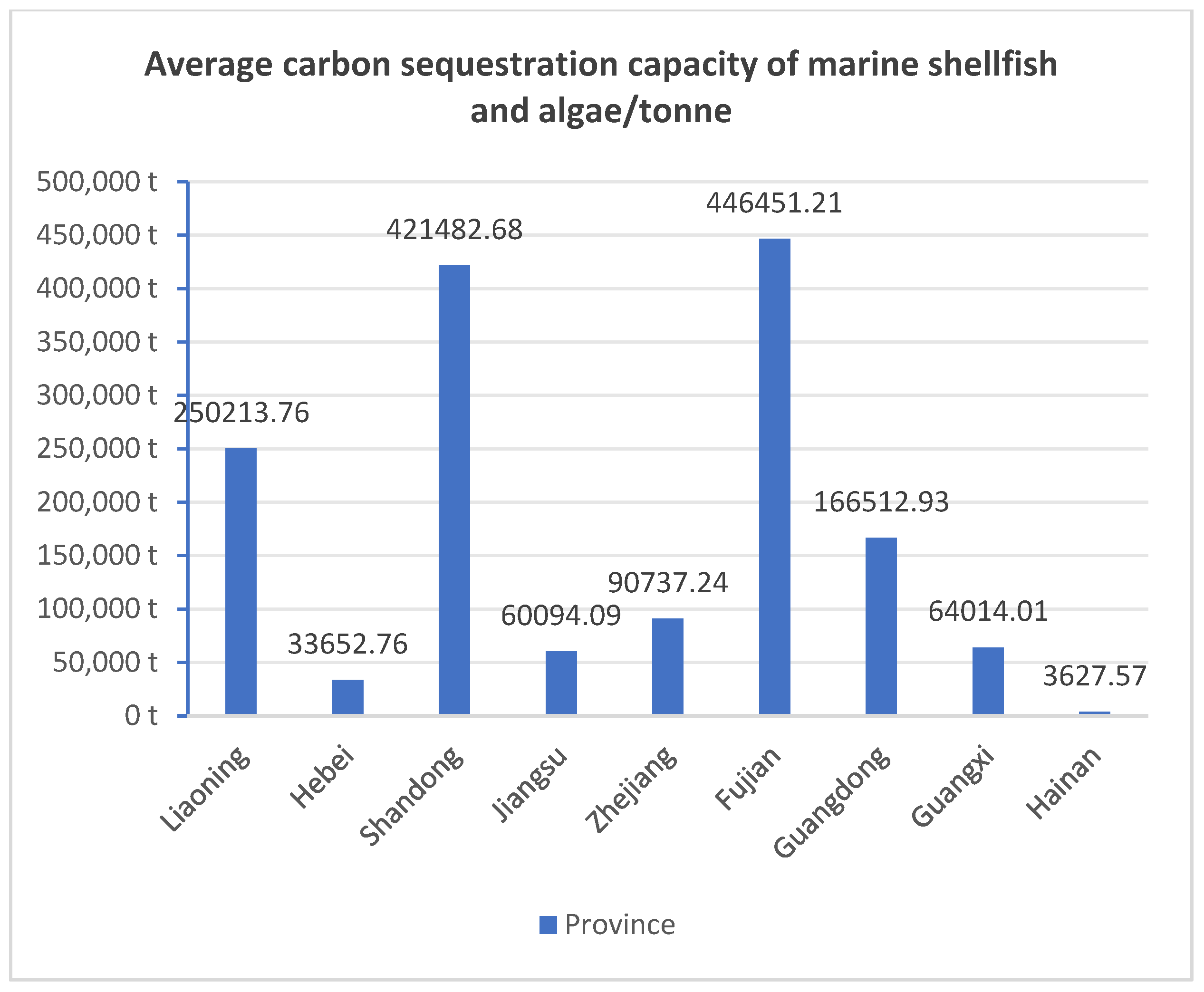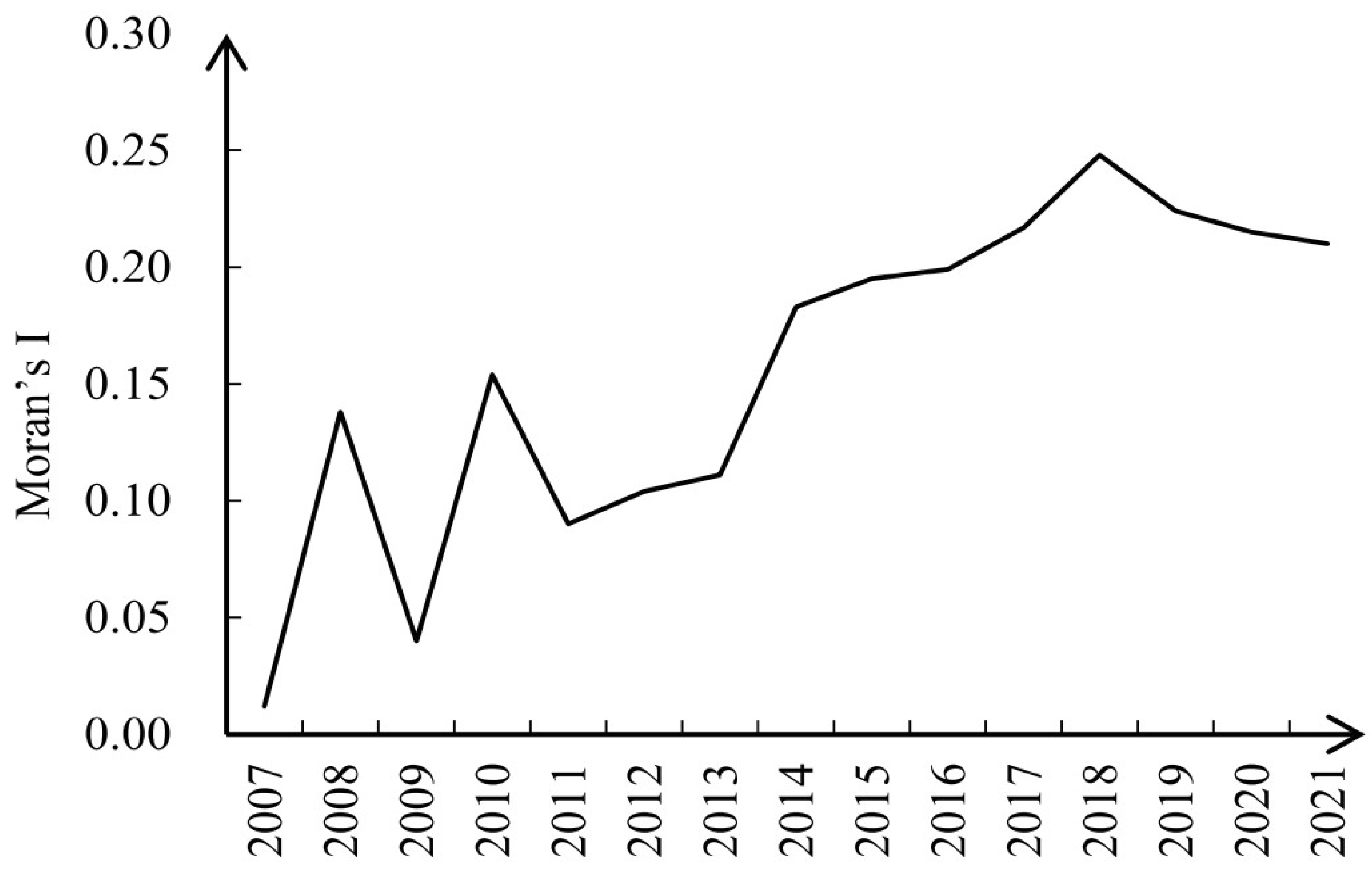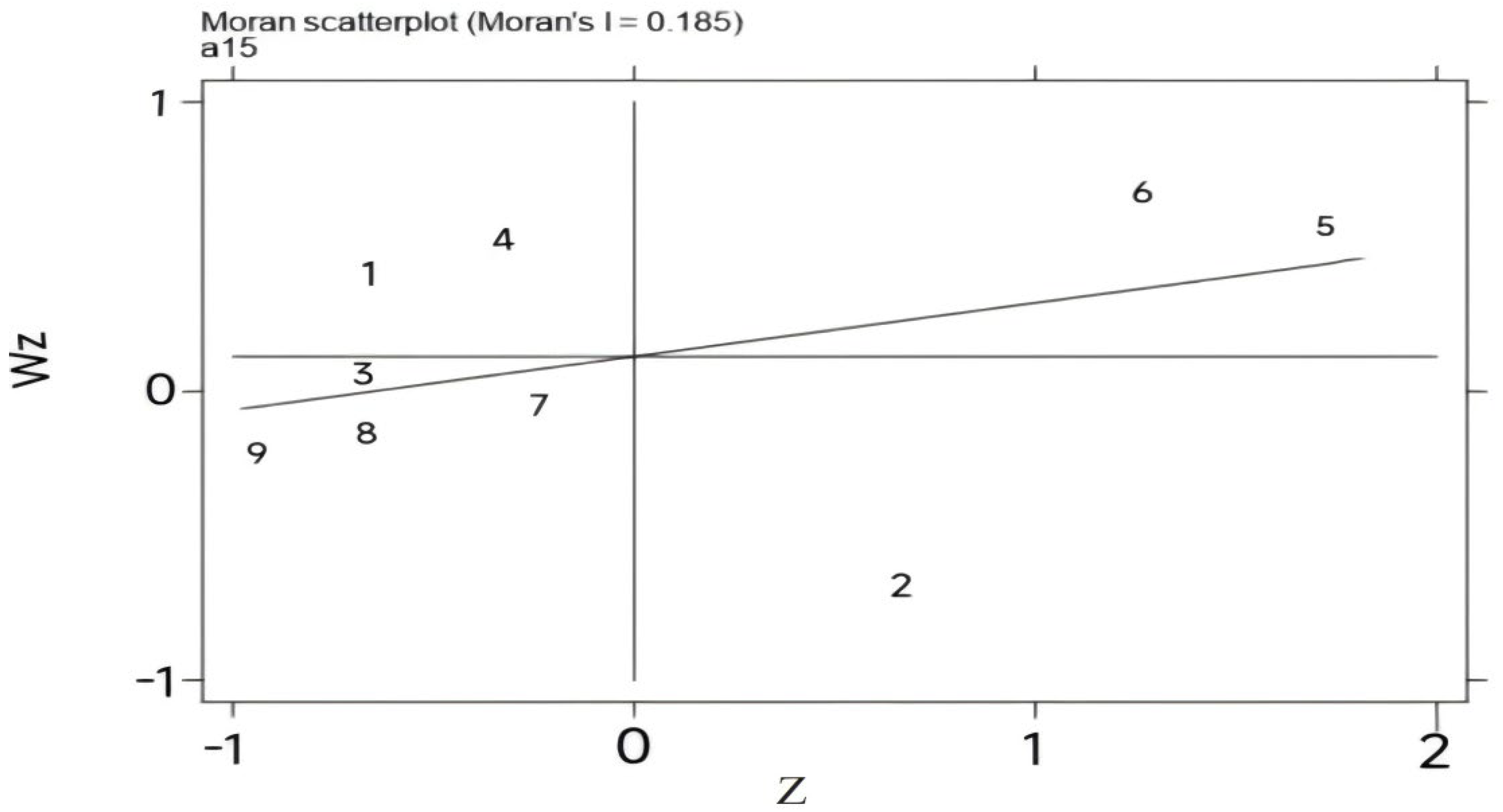Research on Carbon Sink Effect of Marine Shellfish and Algae in China
Abstract
1. Introduction
2. Literature Review
2.1. Research on the Theory of Marine Carbon Sequestration
2.2. Research on Marine Carbon Sequestration Accounting
2.3. Research on Factors Influencing Marine Shellfish and Algae Carbon Sequestration
3. Material and Methods
3.1. Measurement of Carbon Sequestration Capacity of Marine Shellfish and Algae
3.2. Data Sources
3.3. Descriptive Statistics
3.4. Calculation Results and Analysis of Carbon Sink Capacity in Marine Shellfish and Algae
3.4.1. Analysis of the Temporal Changes in Chinese Marine Shellfish and Algae Carbon Sink Capacity
3.4.2. Analysis of Regional Distribution of Carbon Sink Capacity in Chinese Marine Shellfish and Algae
4. Analysis of Spatial Effects on Marine Shellfish and Algae Carbon Sink Capacity
4.1. Specification of Spatial Econometric Model
4.1.1. Spatial Correlation Test
4.1.2. Construction of Spatial Econometric Mode
4.2. Selection of Influencing Factors
4.3. Results and Analysis of Spatial Effects on Marine Shellfish and Algae Carbon Sink Capacity
4.3.1. The Results of Spatial Correlation Test
4.3.2. Analysis of Regression Results from the Spatial Durbin Model
4.3.3. Analysis of Spatial Spillover Effects
4.3.4. Discussion
5. Conclusions and Recommendations
- (1)
- In terms of the temporal and spatial dynamics of the carbon sequestration capacity of marine shellfish and algae, from 2007 to 2009, the carbon sequestration capacity of the nine coastal provinces in China showed a trend of first increasing and then decreasing, and from 2010 to 2021, it continued to grow. This fluctuation is in line with the global goals of marine ecosystem restoration and sustainable management. At the spatial distribution level, there are significant differences in the carbon sequestration capacity among provinces. Regions such as Fujian and Shandong have relatively high average carbon sequestration capacities, while Hainan and Hebei are relatively low. This characteristic reflects the common problem of uneven distribution of marine carbon sink resources on a global scale. It also indicates that strategies for enhancing marine carbon sinks need to be formulated according to local conditions to conform to the overall plan of international marine carbon sink capacity building.
- (2)
- The study of spatial effects shows that there is a positive spatial correlation in the carbon sequestration capacity of marine shellfish and algae in China’s coastal provinces, but the degree of agglomeration fluctuates, presenting the characteristics of “high–high agglomeration and low–low agglomeration”. This is consistent with the international research conclusions on the spatial correlation of marine ecosystems, suggesting that when formulating marine carbon sink policies, full consideration should be given to regional synergistic effects, inter-regional cooperation should be strengthened, and an efficient marine carbon sink network should be promoted to enhance the overall marine carbon sequestration capacity and achieve the marine carbon sink goals under the United Nations Framework Convention on Climate Change.
- (3)
- The analysis of influencing factors shows that factors such as the aquaculture output of marine shellfish and algae, scientific and technological investment, promotion, and disaster response have a positive direct impact on the carbon sequestration capacity, while labor input has a negative direct effect. At the same time, the development level, aquaculture output, scientific and technological investment, and promotion have a positive indirect impact, while labor input has a negative indirect impact. These findings are highly consistent with the international policy orientation of promoting the development of marine carbon sinks through scientific and technological innovation and industrial upgrading. They emphasize the importance of optimizing resource allocation, increasing investment in scientific and technological research and development and promotion, and improving the industrial development level in enhancing the marine carbon sequestration capacity, providing practical evidence for realizing the release of global marine carbon sink potential and the goal of carbon neutrality.
- (1)
- Optimize the structure of marine fisheries aquaculture species and increase shellfish and algae aquaculture production. Explore the value of marine fisheries aquaculture species by extending product chains and developing derivative products, increase the demand for shellfish and algae products, optimize the structure of marine aquaculture species, promote the expansion of marine fisheries carbon sequestration, and enhance the carbon sequestration function of marine fisheries. Vigorously carry out technical training and promotional activities. Organize aquaculture farmers to attend professional training courses, and invite industry experts to systematically explain knowledge such as aquaculture techniques for shellfish and algae, key points of variety breeding, and strategies for disease and pest control. Meanwhile, establish demonstration bases for aquaculture technology to showcase intuitive aquaculture models and management experiences, providing learning examples for aquaculture farmers, and widely disseminate aquaculture technologies through multiple online and offline channels.
- (2)
- Increase funding and improve aquaculture technology. The government should increase funding for research and projects to promote the improvement of aquaculture technology. Meanwhile, coastal provinces should strengthen technical exchanges and focus on scientific and technological innovation in marine fisheries aquaculture to increase marine fisheries production and output value. Strengthen the cooperation among domestic scientific research institutions, universities, and enterprises, establish a collaborative innovation mechanism integrating production, education, research, and application, and jointly carry out the research, development, and application promotion of aquaculture technologies. Actively engage in technical exchanges and cooperation with advanced international aquaculture institutions and enterprises, introduce foreign advanced technologies, equipment, and management experiences, and conduct digestion, absorption, and re-innovation. Establish an aquaculture technology promotion service system, improve the three-level (county, township, and village) technology promotion network, equip it with professional technical personnel to provide in-depth technical guidance and training at aquaculture bases, construct demonstration parks for aquaculture technologies to showcase advanced technological achievements, and enhance the enthusiasm of aquaculture farmers in applying technologies.
- (3)
- Strengthen cooperation among provinces and fully leverage marine advantages. In response to the current situation of marine fisheries carbon sequestration capacity development in China, promote the flow of factors among coastal provinces, achieve coordinated development and common progress, fully leverage Chinese marine advantages, and contribute marine power to achieving the “carbon neutrality” goal.
Author Contributions
Funding
Institutional Review Board Statement
Informed Consent Statement
Data Availability Statement
Conflicts of Interest
References
- Yang, L.; Hao, X.; Shen, C.; An, D. Assessment of Carbon Sink Capacity and Potential of Marine Fisheries in China under the Carbon Neutrality Goal. Resour. Sci. 2022, 44, 716–729. [Google Scholar]
- Zhao, Y. Analysis on the Temporal Change and Regional Difference of Marine Fisheries Competitiveness in China. Mar. Econ. 2021, 11, 36–44. [Google Scholar]
- Sun, K.; Li, L. Analysis on the Effectiveness and Spatio-Temporal Differences of Marine Fisheries Transformation in China. Ind. Econ. Rev. 2018, 9, 72–83. [Google Scholar]
- Guan, H.; Chen, Y.; Zhao, A. Assessment of Carbon Neutrality Capacity of Marine Fisheries in China. J. Agric. Sci. Technol. China 2023, 25, 215–224. [Google Scholar]
- Tang, Q.; Jiang, Z.; Mao, Y. Definition and Discrimination of Fisheries Carbon Sink and Carbon Sink Fisheries and Related Issues. Prog. Fish. Sci. 2022, 43, 1–7. [Google Scholar]
- Nellemann, C.; Corcoran, E.; Duarte, C.M.; Valdrés, L.; Young, C.D.; Fonseca, L.; Grimsditch, G. Blue Carbon. A Rapid Response Assessment; UNEP, GRID-Arendal: Arendal, Norway, 2009. [Google Scholar]
- Li, J.; Wen, G.; Yang, X. Mechanism and Development Strategies of Marine Carbon Sink. Ocean. Dev. Manag. 2018, 35, 11–15. [Google Scholar]
- Hamilton, T.L.; Having, J.R. Inorganic carbon addition stimulates snow algae primary productivity. ISME J. 2020, 14, 857–860. [Google Scholar] [CrossRef] [PubMed]
- Rodríguez-Martínez, R.; Leonard, G.; Milner, D.S.; Sudek, S.; Conway, M.; Moore, K.; Hudson, T.; Mahé, F.; Keeling, P.J.; Santoro, A.; et al. Controlled sampling of ribosomally active protistan diversity in sediment-surface layers identifies putative players in the marine carbon sink. ISME J. 2020, 14, 948–998. [Google Scholar] [CrossRef]
- Liu, M.; Cao, Y.; Gao, X.C. Research Progress on the Carbon Sequestration Mechanism and Carbon Footprint of Marine Shellfish. Trans. Oceanol. Limnol. 2025, 21, 1–10. [Google Scholar]
- Jiao, N.; Liu, J.; Shi, T.; Zhang, C.; Zhang, Y.; Zheng, Q.; Chen, Q.; Tang, K.; Wang, Y.; Dong, H.; et al. Implementing Marine Negative Emissions to Fulfill the Carbon Neutrality Strategy. Sci. China Earth Sci. 2021, 51, 632–643. [Google Scholar]
- Ye, W.; Zhang, M.; Sun, H.; Gao, Z.; Zhang, J.; Li, Y.; Yan, J.; Xu, C.; Zhao, S.; Wu, M.; et al. Research Progress on Carbon Sink Accounting of Shellfish and Algae Aquaculture and Comprehensive Greenhouse Gas Potential Assessment. J. Appl. Oceanogr. 2022, 41, 715–723. (In Chinese) [Google Scholar]
- Yue, D.; Wang, L. The Relationship between the Production of Marine Shellfish Aquaculture and Its Carbon Sink in China. Jiangsu Agric. Sci. 2012, 40, 246–248. [Google Scholar]
- Turolla, E.; Castaldelli, G.; Fano, E.A.; Tamburini, E. Life cycle assessment (LCA) proves that manila clarm farming (Ruditapes Philippinarum) is a fully sustainable aquaculture practice and a carbon sink. Sustainability 2020, 12, 5252. [Google Scholar] [CrossRef]
- Yue, D. Scenario Analysis of the Changes in Kelp Aquaculture Structure and Accounting of Carbon Sink from Seaweed Aquaculture. Fujian J. Agric. Sci. 2012, 27, 432–436. [Google Scholar]
- Li, R.; Zhong, C.; Zheng, S.; Lin, Q.; Xi, Y.; Guo, C. Macroalgal Carbon Sink: Carbon Sequestration Mechanisms, Assessment Methods, and Impacts of Environmental Factors. Fish. Res. 2025, 21, 1–15. [Google Scholar]
- Shao, G.; Chu, R.; Li, C. Research on Carbon Balance of Marine Fisheries Based on Carbon Emission and Carbon Sink Accounting: A Case Study of Shandong Province. Chin. Fish. Econ. 2018, 36, 4–13. [Google Scholar]
- Shao, G.; Liu, B.; Li, C. Assessment of Carbon Sink Capacity of Marine Aquaculture in Major Sea Areas of China and Its Impact Effects: Based on Panel Data from Nine Coastal Provinces in China. Acta Ecol. Sin. 2019, 39, 2614–2625. [Google Scholar]
- Sun, K.; Cui, Q.; Su, Z.; Wang, Y. Analysis on the Spatio-Temporal Evolution and Influencing Factors of Economic Value of Carbon Sink from Marine Aquaculture in China. Geogr. Res. 2020, 39, 2508–2520. (In Chinese) [Google Scholar]
- Ren, W.H. Study on the removable carbon sink estimation and decomposition of influencing factors of mariculture shellfish and algae in China: A two-dimensional perspective based on scale and structure. Environ. Sci. Pollut. Res. Int. 2021, 28, 21528–21539. [Google Scholar] [CrossRef]
- Xu, J.; Zhang, J.; She, C. Evaluation of the Spillover Effect of Green Development Space in Marine Carbon Sink Fisheries. China Popul. Resour. Environ. 2020, 30, 99–110. [Google Scholar]
- Ji, J.; Wang, P. Measurement of Carbon Sink Capacity of Marine Aquaculture in China and Study on the Decomposition of Its Influencing Factors. Mar. Environ. Sci. 2015, 34, 871–878. [Google Scholar]
- Zhang, L.; Zheng, S.; Yu, L. Measurement of Green Efficiency and Spatial Spillover Effects of Marine Carbon Sink Fisheries in China. Chin. Rural. Econ. 2020, 10, 91–110. [Google Scholar]
- Lesage, J.P.; Pace, R.K. Introduction to Spatial Econometrics; CRC Press: Leiden, The Netherlands, 2010. [Google Scholar]




| Category | Calculation Method for Carbon Sequestration Capacity |
|---|---|
| Shellfish | Shellfish carbon sink capacity = Shell carbon sink capacity + Soft tissue carbon sink capacity |
| Shell carbon sink capacity = Shellfish production × Dry-wet ratio × Shell specific gravity × Shell carbon sink coefficient | |
| Soft tissue carbon sink capacity = Shellfish production × Dry-wet ratio × Soft tissue specific gravity × Soft tissue carbon sink coefficient | |
| Algae | Algae carbon sink capacity = Algae production × Dry-wet ratio × Algae carbon sink coefficient |
| Total amount | Marine fisheries carbon sink capacity = Shellfish carbon sink capacity + Algae carbon sink capacity |
| Province | Hebei | Liaoning | Jiangsu | Zhejiang | Fujian | Shandong | Guangdong | Guangxi |
|---|---|---|---|---|---|---|---|---|
| Mean standard error | 10,743.46 | 91,831.13 | 13,893.51 | 23,185.79 | 267,590.72 | 185,296.42 | 452,272.99 | 18,370.18 |
| Median | 600.00 | 115,725.00 | 300.00 | 27,932.00 | 658.00 | 690.00 | 282,385.00 | 727.00 |
| Standard deviation | 18,608.23 | 159,056.18 | 24,064.26 | 40,158.97 | 463,480.73 | 320,942.82 | 783,359.80 | 31,818.08 |
| Skewness | 1.73 | 1.73 | 0.76 | 1.73 | 1.73 | 1.73 | 1.73 | 1.73 |
| Deviation standard error | 1.23 | 1.23 | 1.23 | 1.23 | 1.23 | 1.23 | 1.23 | 1.23 |
| Name of Influencing Factors | Explanation |
|---|---|
| Level of Marine Shellfish and Algae Development | Total Economic Output of Mariculture (in CNY 10,000) |
| Aquaculture Output of Marine Shellfish and Algae | Aquaculture Production (in Tonnes) |
| Aquaculture Area of Marine Shellfish and Algae | Aquaculture Area (in Hectares) |
| Labor Input in Marine Shellfish and Algae | Number of Employees in Marine Shellfish and Algae (in Persons) |
| Investment in Marine Shellfish and Algae Science and Technology | Marine Shellfish and Algae Aquaculture Technology Promotion Institutions |
| Promotion Status of Marine Shellfish and Algae Science and Technology | Promotion Funding for Marine Shellfish and Algae Aquaculture Technology (in CNY 10,000) |
| Marine Shellfish and Algae Disasters | Affected Aquaculture Area in Marine Shellfish and Algae (in Hectares) |
| Type of Test | Statistical Value | p-Value |
|---|---|---|
| Hausman | 30.83 | 0.00 |
| LR-lag | 35.02 | 0.00 |
| LR-error | 48.30 | 0.00 |
| Wald-lag | 212.63 | 0.00 |
| Wald-error | 127.43 | 0.00 |
| Variable | SDM | Spatial Effect | Variance |
|---|---|---|---|
| lnDI | 0.137 (0.50) | ||
| lnAP | 0.930 *** (0.00) | ||
| lnCA | −0.143 (0.49) | ||
| lnLI | 0.100 (0.70) | ||
| lnSTI | 0.360 *** (0.00) | ||
| lnSTP | −0.057 (0.52) | ||
| lnDT | 0.040 (0.15) | ||
| rho | 0.254 *** (0.00) | ||
| sigma2_e | 0.053 *** (0.00) |
| Variable | Direct Effect | Indirect Effect | Total Effect |
|---|---|---|---|
| lnDI | 0.113 | 0.580 * | 0.693 |
| lnAP | 1.617 *** | 1.185 *** | 2.802 *** |
| lnCA | 0.150 | −0.227 | −0.077 |
| lnLI | −0.847 *** | −2.140 *** | −2.987 *** |
| lnSTI | 0.277 * | 0.880 *** | 1.157 *** |
| lnSTP | 0.245 *** | 0.349 ** | 0.595 *** |
| lnDT | 0.071 * | 0.017 | 0.088 |
Disclaimer/Publisher’s Note: The statements, opinions and data contained in all publications are solely those of the individual author(s) and contributor(s) and not of MDPI and/or the editor(s). MDPI and/or the editor(s) disclaim responsibility for any injury to people or property resulting from any ideas, methods, instructions or products referred to in the content. |
© 2025 by the authors. Licensee MDPI, Basel, Switzerland. This article is an open access article distributed under the terms and conditions of the Creative Commons Attribution (CC BY) license (https://creativecommons.org/licenses/by/4.0/).
Share and Cite
Zheng, P.; Chu, T.; Zhao, W.; Liu, Y. Research on Carbon Sink Effect of Marine Shellfish and Algae in China. Fishes 2025, 10, 270. https://doi.org/10.3390/fishes10060270
Zheng P, Chu T, Zhao W, Liu Y. Research on Carbon Sink Effect of Marine Shellfish and Algae in China. Fishes. 2025; 10(6):270. https://doi.org/10.3390/fishes10060270
Chicago/Turabian StyleZheng, Peng, Tianrang Chu, Wei Zhao, and Yongquan Liu. 2025. "Research on Carbon Sink Effect of Marine Shellfish and Algae in China" Fishes 10, no. 6: 270. https://doi.org/10.3390/fishes10060270
APA StyleZheng, P., Chu, T., Zhao, W., & Liu, Y. (2025). Research on Carbon Sink Effect of Marine Shellfish and Algae in China. Fishes, 10(6), 270. https://doi.org/10.3390/fishes10060270






